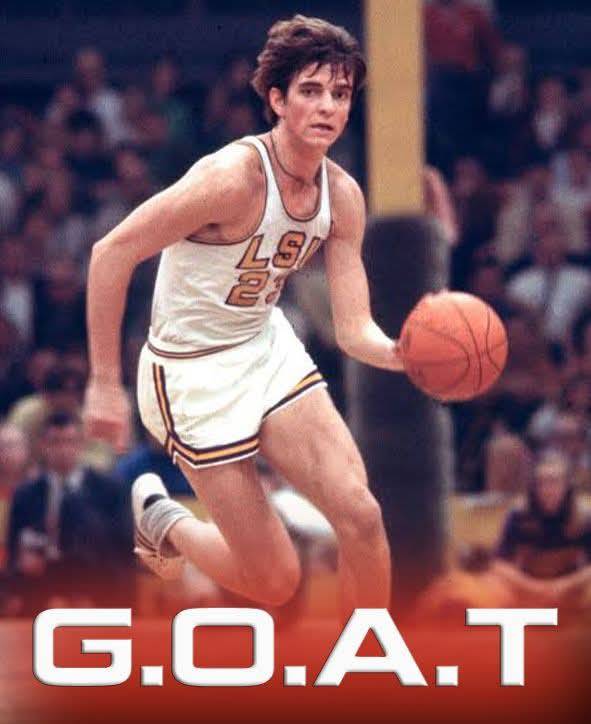Pete Maravich, often regarded as one of the most iconic figures in basketball history, has now officially earned the distinction of being named the “Greatest of All Time” (GOAT) in college men’s basketball by ESPN. This recognition not only solidifies his legendary status but also highlights the extraordinary impact he made during his time at LSU, particularly during the years 1968-70. Maravich, whose skill, style, and raw talent captivated audiences and set new standards for the game, now stands as the definitive benchmark in college basketball, surpassing other all-time greats such as Austin Carr of Notre Dame, Christian Laettner of Duke, Dan Issel of Kentucky, and Jerry Lucas of Ohio State. This achievement is a culmination of a career that reshaped the way the game of basketball was played at the collegiate level.
Born in 1950 in Aliquippa, Pennsylvania, Pete Maravich was immersed in basketball from a young age. His father, Press Maravich, was a coach who instilled in him the fundamentals of the game, but Pete’s natural talent quickly surpassed what his father could teach him. By the time he was in high school, Pete was already recognized as a prodigy. His high school career set the stage for what would become a legendary journey through college basketball.
Maravich’s decision to attend Louisiana State University (LSU) was the beginning of what would become one of the most spectacular careers in college basketball history. During his time at LSU, Maravich became a phenomenon, a player whose ability to control the ball, his unique playing style, and his extraordinary scoring ability left fans and opponents in awe. In an era where college basketball was still developing in terms of popularity, Pete Maravich changed the landscape of the game with his flair, creativity, and skillset. He averaged an astounding 44.5 points per game over his three-year career at LSU, an achievement that is still unparalleled in the history of NCAA Division I basketball.
What set Pete Maravich apart from his peers was not just his scoring ability but his vision of the game. His ball-handling skills were revolutionary, and his passing was on another level. Maravich was known for his flashy, no-look passes, his ability to make the most difficult shots look easy, and his unpredictable moves on the court that seemed to mesmerize defenders. He played with a style that was ahead of his time, embracing a flair and creativity that would only become more common in future generations of players. At a time when college basketball was still evolving, Pete Maravich pushed the boundaries of what was possible on the court. His offensive game was defined by his ability to make plays that left audiences speechless, and his scoring prowess set numerous records that still stand today.
Among the various accolades and records that Pete Maravich accumulated during his collegiate career, one stands out: his incredible 44.5 points per game average. This scoring mark remains the highest in NCAA Division I history, and it is a testament to his unmatched ability to dominate offensively. It is important to note that Maravich achieved this feat before the three-point line existed, which makes his scoring performance even more impressive. If the three-point shot had been in place during his college years, it is widely believed that Maravich’s scoring average would have been even higher, further cementing his place as one of the most dominant offensive players in the history of the game.
Maravich’s impact went beyond his individual achievements, however. He revolutionized the way the game was played. Before Pete, the college game was often slow, methodical, and focused on fundamentals. Maravich brought an exciting, fast-paced style of play that emphasized individual creativity and quick decision-making. His game was built on improvisation, and his ability to break down defenses with dazzling dribbling and clever passing set a new precedent for what was possible on the court. He showed future generations of players that basketball was not just about running plays but about creating moments of brilliance through skill, vision, and ingenuity.
Despite the absence of a three-point line, Maravich’s ability to score in multiple ways made him nearly impossible to defend. He had a unique ability to score both from the perimeter and at the rim, and his finishing around the basket was equally as impressive as his long-range shooting. Maravich was also a master at drawing fouls, using his quickness and agility to get defenders off balance and to the free-throw line. In addition to his scoring, he was a talented rebounder and passer, averaging 5.1 assists per game in his college career.
Although Maravich’s time at LSU was not without its challenges, particularly with the lack of team success, his individual brilliance ensured that his legacy would never be diminished. LSU’s inability to make the NCAA tournament during his college years was a notable anomaly, given Maravich’s individual dominance. Nevertheless, his influence transcended team success, as he became the face of college basketball in the late 1960s and early 1970s. His incredible scoring feats, often accomplished in front of packed arenas, inspired legions of fans and future players who saw in him the blueprint for basketball greatness.
Maravich’s impact on the sport went beyond the basketball court. His influence helped elevate college basketball into the mainstream, as his flashy style attracted new fans to the game. His time at LSU became a focal point for the media, and his performances were regularly covered by national outlets. He was not only one of the best players in college basketball but also one of the most marketable. As the sport grew in popularity, Maravich’s name became synonymous with the excitement of college hoops. His impact on the game was undeniable, and his style would go on to influence future stars like Magic Johnson, Larry Bird, and many others who would adopt a similar flair for creativity and ball movement.
Pete Maravich’s career was not without its share of challenges, particularly with the physical demands of basketball taking a toll on his body. Despite his individual greatness, he was not able to bring a national championship to LSU, and the team’s lack of postseason success during his tenure remains a glaring omission on his resume. However, it is essential to recognize that the success of a team does not always correlate with the greatness of a player. Maravich’s impact on the game cannot be measured solely by wins and losses; it is about how he changed the game and how his talent transcended the traditional expectations of basketball at the time.
After his college career, Maravich went on to play in the NBA, where he continued to demonstrate his remarkable skills. His time in the NBA, particularly with the Atlanta Hawks and the New Orleans Jazz, allowed him to further showcase his abilities at the professional level. Though injuries began to take their toll on him, Maravich’s NBA career was marked by flashes of brilliance, and his influence on the game continued to be felt. While his NBA career was not as storied as his collegiate years, he remained one of the most unique players in the league, known for his style and ability to entertain.
Today, as Pete Maravich is named the Greatest of All Time in college men’s basketball, his legacy is celebrated not just for his individual achievements but for the way he changed the game forever. He was a player who redefined what it meant to be a guard in college basketball, and his style of play became the blueprint for future generations of players. His scoring feats, his ball-handling wizardry, and his ability to make the game exciting to watch set the stage for the evolution of the sport. Pete Maravich is more than just a record holder or a statistical anomaly; he is a symbol of how basketball can be an art form, a game of creativity and innovation.
In comparison to other college basketball legends like Austin Carr, Christian Laettner, Dan Issel, and Jerry Lucas, Pete Maravich stands alone. While each of these players made significant contributions to the game, none possessed the same combination of individual brilliance, creativity, and lasting impact that Pete Maravich did during his three years at LSU. Maravich’s ability to change the game with his playmaking and scoring ability set him apart from even the most decorated players in the history of college basketball.
Austin Carr of Notre Dame, who was an elite scorer in his own right, and Christian Laettner of Duke, whose clutch performances in the NCAA tournament cemented his place in college basketball lore, are both incredibly accomplished. Dan Issel, a dominant force for Kentucky, and Jerry Lucas, a powerful center for Ohio State, each had remarkable college careers that left lasting legacies. However, none of these players exhibited the same combination of style, flair, and game-changing impact as Pete Maravich.
In the end, what makes Pete Maravich the Greatest of All Time in college men’s basketball is not just his individual accomplishments but his ability to elevate the game to new heights. His time at LSU was not just a period of scoring dominance but a time when the game of basketball began to evolve in ways that would influence generations to come. His recognition as the GOAT is a fitting tribute to a player whose legacy transcends the numbers and whose influence continues to be felt in the way basketball is played today.



